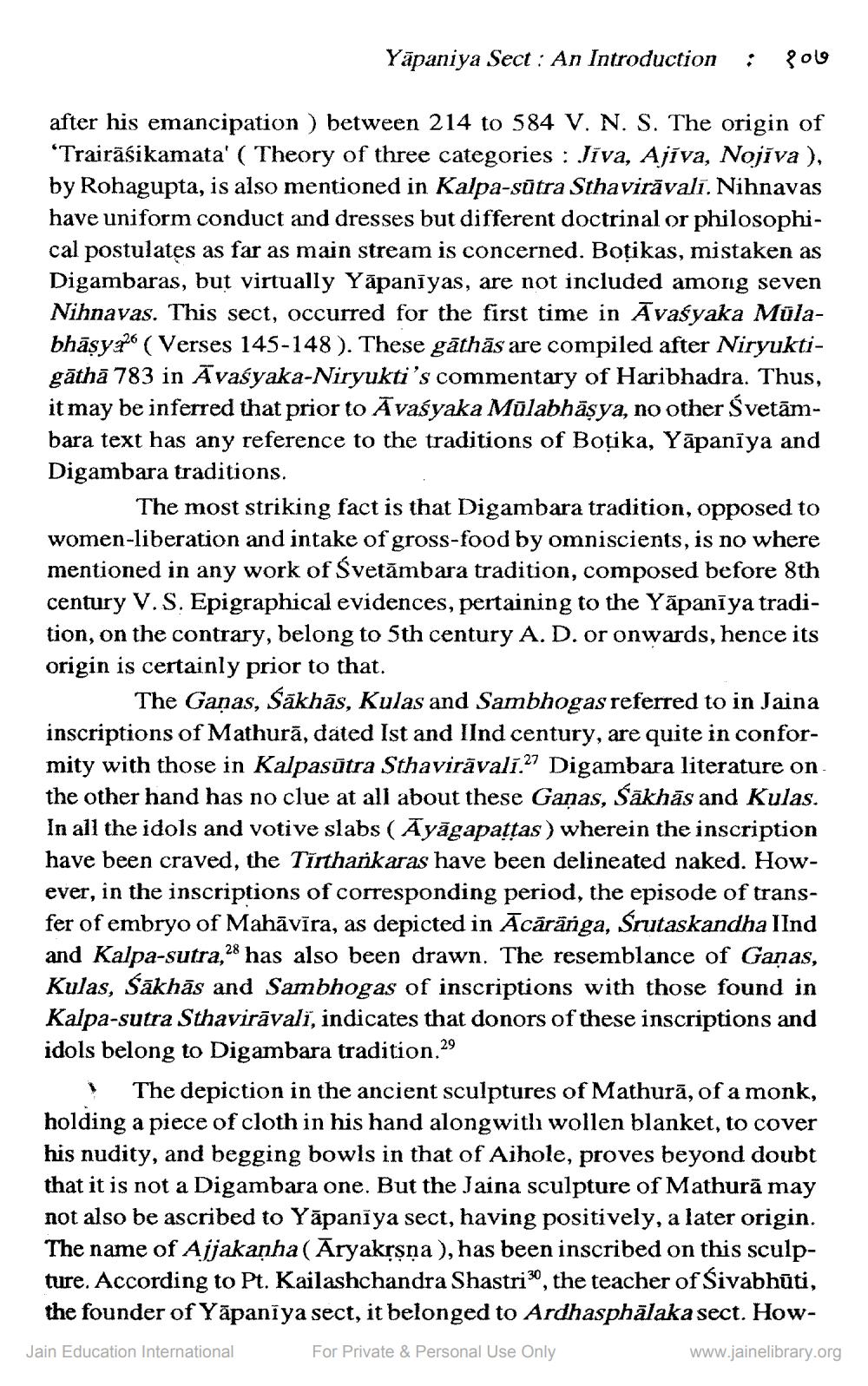________________
Yăpaniya Sect: An Introduction
:
fol
after his emancipation ) between 214 to 584 V. N. S. The origin of *Trairāśikamata' ( Theory of three categories : Jiva, Ajiva, Nojiva ), by Rohagupta, is also mentioned in Kalpa-sūtra Sthavirāvali. Nihnavas have uniform conduct and dresses but different doctrinal or philosophical postulates as far as main stream is concerned. Botikas, mistaken as Digambaras, but virtually Yāpanīyas, are not included among seven Nihnavas. This sect, occurred for the first time in Avaśyaka Mülabhāsyz (Verses 145-148). These gāthās are compiled after Niryuktigāthā 783 in Āvaśyaka-Niryukti's commentary of Haribhadra. Thus, it may be inferred
erred that prior to Avaśyaka Mülabhāsya, no other Svetāmbara text has any reference to the traditions of Botika, Yāpanīya and Digambara traditions.
The most striking fact is that Digambara tradition, opposed to women-liberation and intake of gross-food by omniscients, is no where mentioned in any work of Svetāmbara tradition, composed before 8th century V.S. Epigraphical evidences, pertaining to the Yāpanīya tradition, on the contrary, belong to 5th century A. D. or onwards, hence its origin is certainly prior to that.
The Gaņas, sākhās, Kulas and Sambhogas referred to in Jaina inscriptions of Mathurā, dated Ist and Ilnd century, are quite in conformity with those in Kalpasūtra Sthavirāvali.27 Digambara literature on the other hand has no clue at all about these Ganas, Šakhās and Kulas. In all the idols and votive slabs ( Āyāgapattas ) wherein the inscription have been craved, the Tirtharikaras have been delineated naked. However, in the inscriptions of corresponding period, the episode of transfer of embryo of Mahāvīra, as depicted in Ācārânga, Srutaskandha IInd and Kalpa-sutra,28 has also been drawn. The resemblance of Ganas, Kulas, Sākhās and Sambhogas of inscriptions with those found in Kalpa-sutra Sthavirāvali, indicates that donors of these inscriptions and idols belong to Digambara tradition.29
The depiction in the ancient sculptures of Mathurā, of a monk, holding a piece of cloth in his hand alongwith wollen blanket, to cover his nudity, and begging bowls in that of Aihole, proves beyond doubt that it is not a Digambara one. But the Jaina sculpture of Mathurā may not also be ascribed to Yāpanïya sect, having positively, a later origin. The name of Ajjakanha (Aryakrsna), has been inscribed on this sculpture. According to Pt. Kailashchandra Shastri 30, the teacher of Sivabhūti, the founder of Yāpaniya sect, it belonged to Ardhasphālaka sect. How
Jain Education International
For Private & Personal Use Only
www.jainelibrary.org




